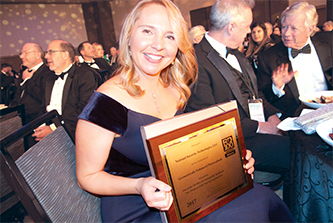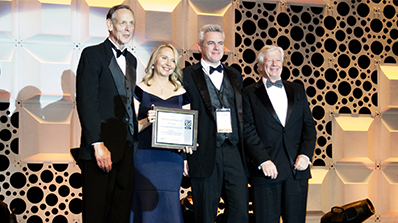The Nevada National Security Site’s Geometrically Enhanced Photocathode project was selected as a winner for this year’s 55th annual R&D 100 Awards, which took place Friday, Nov. 17, as part of the third annual R&D 100 Conference in Lake Buena Vista, Florida.
The Geometrically Enhanced Photocathode project was led by Principal Scientist Dr. Kathy Opachich of the NNSS’ Livermore Operations (LO) in Livermore, California. Opachich accepted the award along with NNSS Site Director James Holt.
Long considered the most globally prestigious recognition of invention and innovation, the R&D 100 Awards honor the 100 most innovative technologies of the past year. This is NNSS’ fifth win since 2009. Additionally, one of the Site’s projects was a finalist in 2015.
“I am excited to represent the NNSS and to share this work with the rest of the scientific community,” Opachich said upon winning the R&D 100 Award. “This award is a wonderful way to reward the extraordinary amount of work that goes into scientific and technological innovation.”
Opachich worked with LO colleagues and collaborators from Lawrence Livermore National Laboratory, Lawrence Berkeley National Laboratory, General Atomics and Nanoshift, LLC, to develop the recessed geometrically enhanced photocathode designed to improve high-energy efficiency in X-ray detectors.

“This project is a perfect example of what can happen when a scientist sees a problem and asks, ‘What if?’” Holt said. “Scientifically curious and courageous minds have revolutionized business as usual in so many ways, and I couldn’t be more proud of our team and the work they’ve done on this project.”
Scientific X-ray detectors are used to take snapshots of quickly changing phenomenon under extreme conditions that do not exist naturally on Earth. These detectors are designed to work at specific X-ray energies and need to be upgraded to collect good data outside of their working range. As part of the project, a structured cathode has been designed, fabricated and tested in an X-ray detector. The cathode was designed to improve images (make them sharper and brighter) without changing the accuracy of the data. The cathode was first modeled in computer software, then sent to Nanoshift to develop a fabrication recipe and make a prototype. The final cathode was tested in an actual X-ray detector to show that it improves the collected data without any compromise. The device can be changed to suit any X-ray detector and can be easily made and tested.
“The geometrically enhanced photocathode proves that we can push the limits on what we can do in quantum efficiency—that is, improve our ability to see finer detail in the dynamics of fusion experiments than before. Not being able to do this previously is what has limited our progress. With this geometrically enhanced photocathode, we’re getting better and more data, and it lets us view the dynamics of fusion much more clearly,” said Howard Bender, distinguished scientist and Site-Directed Research and Development manager at the NNSS’ Los Alamos Operations in Los Alamos, New Mexico.
Bender mentioned that the geometrically enhanced photocathode would be useful in other scientific research for probing states of matter, molecular dynamics, high-speed streak cameras and potential medical applications.
In addition to an R&D 100 Award, this innovation resulted in a full patent and several publications.

